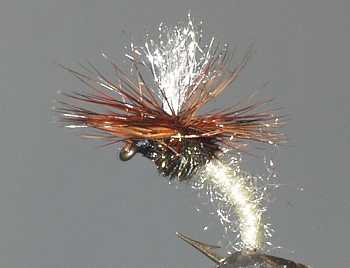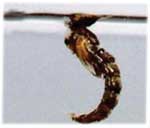Cream Klinkhammer Emerging Nymph fly
Dutch angler Hans Van Klinken originally tied the Klinkhammer fly as an emerging caddis pattern to catch grayling feeding on them as they floated in the surface film.

KLINKHAMMER EMERGING FLY PATTERNS. Hook size 12 14 16 - $US each
The Klinkhammer Emerger Nymph fly is a fantastically popular pattern that has caught trout and grayling all over Europe. This floating fly is just like an iceberg: it gives it's best results when 90 per cent of it is under the water. The white top hackle makes it more visible to the fly fisher. I highly recommend this fly. It does what it is designed to do. It imitates the natural insect and catches fish.
Although Dutchman Hans Van Klinken originally tied this fly as an emerging caddis pattern it can be very successfully used for other emerging midge and mayfly nymphs. Hans also fished many of the rivers in Scandinavia as well as in his native Holland. His mentor was a Swedish fly fisher, Kenneth Bostrom who had created a fly called the Rackelhammer to imitate hatching sedge. It floated when cast upstream but Hans found if it was tweaked, to suggest life, it sank. Hans adapted the idea and made a fly that still floated after it had been tweaked. It became known as the Klinkhammer Special . At first he bent the hook of a parachute fly so that the abdomen would sink below the surface and the thorax would float. Later he developed a special hook that did the same but imitated the curved body angle of the insect as it hangs below the surface just as it starts to emerge. This is what makes it different from a regular parachute dry fly. The abdomen serves as a primary trigger, penetrating the surface film and getting noticed by trout from a great distance, well before they pick up on the above surface footprint features.

It is a fantastically popular pattern that has caught trout and grayling all over Europe and now is gaining popularity in North America. This floating fly is just like an iceberg: it gives it's best results when 90 per cent of it is under the water. The white top hackle makes it more visible to the fly fisher. I highly recommend this fly. It does what it is designed to do. It imitates the natural insect and catches fish. On the other side of the Atlantic Mike Monroe developed a fly similar to the Klinkhammer which he called the Paratilt. Mike wrote an article about his new design that was published in the summer issue in 1979. Hans Van Klinken's fly won the race for global acceptance of the Klinkhammer name for this emerger pattern. On my last fishing trip to the USA I landed numerous trout during the morning session, using an olive bodied Klinkhammer but when I tried a cream bodied version it was not as successful. This all changed later on whilst fishing a green drake hatch. The olive Kilinkhammer was now not having the same pulling power. Being new to the area I caught a natural flying green drake insect and had a good look at it. I noticed that its abdomen had a cream stripe. I switched to a cream colored Klinkhamer, and the results were astounding. I hooked and landed fish after fish. It was an amazing day.
Tiny Chironomid flies that inhabit lakes and slow-flowing rivers are more commonly known as midges or buzzers. They appear in vast swarms on most still-waters towards the evenings. They can tolerate relatively high levels of pollution. Where they congregate on the windward side of a lake their tiny larvae and pupae are scooped up in large numbers by surface feeding trout. Dr H A Bell developed the original buzzer as an imitation of the midge pupa. They are at their most vulnerable when they make their journey to the surface. The pupae drift gently up to the surface where the survivors struggle to break through the surface film. Many do not make it, especially if the water is very choppy or if a flat calm has allowed oily film to form. At this stage trout patrol the surface sipping in huge quantities of hatching midges.
The Klinkhammer can be fished just bellow the surface by greasing all but the last three inches of the leader. If there is a single ripple, an occasional twitch of the fly line is enough to attract attention. In flat calm conditions it is usually better to fish the buzzer static in the surface film. An alternative tactic is to degrease the leader and allow the buzzer to sink very slowly. Using this technique you should be ready for takes 'on the drop', as a trout seizes the buzzer some distance below the surface. I have had many takes sitting this buzzer 2-4 feet below a dry fly used as an indicator and fished close to weed beds in shallow water. In winter this fly has excelled for me when trout are still taking buzzers as part of their diet.
When the mayflies have stopped emerging and the surface action has died down. The fishing is not over if you know where to look. Go for a walk down the riverbank and look for bankside eddies, areas of slow slack pockets of water near faster moving water. A lot of mayflies do not successfully emerge during the hatch. They are referred to as cripples or stillborn. Others are flipped over, capsized in choppy water. They seem to collect in these eddies. You will find trout rising to them long after the original hatch has finished. Cast a Klinkhammer into these pockets and let it drift. It is a great way to extend your surface fishing time.
Fly Fishing books

